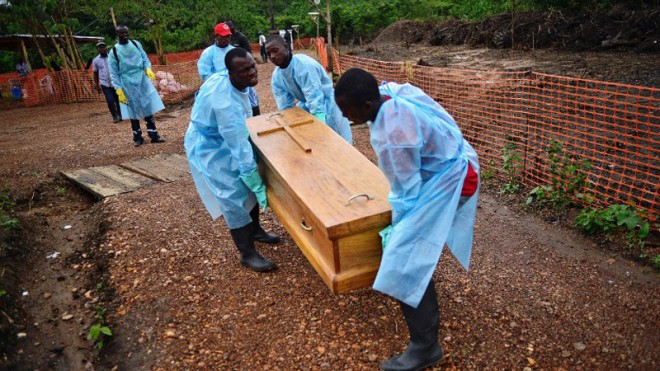Ebola highlights growing global virus threat

Sierra Leonese government burial team members wearing protective clothing carry the coffin of an Ebola victim on August 14, 2014 in Kailahun (AFP Photo/Carl De Souza)
Paris – Like the Spanish flu, polio, AIDS, and SARS before it, Ebola has erupted from seemingly nowhere to claim lives and sow fear of a catastrophic global outbreak.
While experts say the current epidemic is unlikely to become global, they warn of ever more viral outbreaks in future as increasing numbers of globetrotters are exposed to strange new pathogens that they take home to spread in crowded cities.
“New viral diseases are on the rise as populations become more dense and mobile,” said Arnaud Fontanet, head of epidemiology at France’s Insitut Pasteur.
Add to this habitat loss from deforestation and climate change forcing pathogen-carrying animals closer to human settlements, and you have all the ingredients for brewing potent pandemics.
“Outbreaks do seem to be getting more frequent,” University of Nottingham molecular virology professor Jonathan Ball told AFP.
“Are we heading for the big one? It wouldn’t be a huge surprise if there’s another (major pandemic) waiting to happen. What that virus will be or when it will happen is tricky to judge. All we can do is monitor and be prepared.”
Perhaps more than any other in recent history, the 2003 outbreak of SARS — a deadly new respiratory disease — raised the specter of the kind of global devastation caused by the 1918-20 Spanish flu that wiped out 50-100 million people.
SARS claimed 800 lives, mainly in Asia, but not before infecting people in nearly 40 countries within weeks and causing a panic that saw flights cancelled, schools closed and sales of surgical masks spike.
Another, even more virulent virus may be lurking around the corner, experts said.
“There are possibly more emerging virus infections because of population increases in those regions of the world where the viruses sit, often in bats or monkeys which in turn are hunted for food,” said virologist John Oxford of the Queen Mary University of London.
New viruses
According to the World Health Organization (WHO), 154 new virus diseases were discovered between 1940 and 2004 — two-thirds of them transmitted to humans from animals.
Viruses, which can only survive in other organisms, usually live undisturbed in their natural animal reservoir, often bats, monkeys or birds, for long periods without bothering humans.
But sometimes they take advantage of an encroaching human presence to jump directly into a new home, or hitch a ride with an intermediary host like a chicken, pig or mosquito.
In one of history’s deadliest examples, that of AIDS, the Human Immunodeficiency Virus (HIV) skipped the species barrier from chimpanzees to humans to claim an estimated 40 million deaths to date.
Some viruses need to mutate to make a species transition — examples include the highly infectious 2009 H1N1 “swine flu” outbreak that claimed some 18,500 lives in 214 countries, and the H5N1 “bird flu” that has killed about 400 people, mainly in southeast Asia, since 2003.
Others merely need to move into a new region to take advantage of the local population’s lack of immunity to spread easily.
One example is the West Nile virus, first identified in Uganda in 1937, which has killed about 1,200 people since emerging in the United States in 1999.
Better equipped
The WHO insisted there was no evidence of outbreaks getting more frequent, “just that we are better at identifying them,” according to spokesman Tarik Jasarevic.
And he stressed that since the SARS pandemic the world has adopted a set of International Health Regulations that requires countries to report outbreaks.
Yet Ball said it was clear that poor countries were struggling to cope — failing health systems are helping to fuel the latest Ebola outbreak, the most serious since 1976.
The hemorrhagic fever-causing virus can be killed with soap and water and is not easily transmissible between humans — requiring direct contact with the bodily fluids of an infected person.
Virologists say infection containment through hand-washing and early virus isolation is what will end epidemics, not drugs.
“As virologists what we should learn from this outbreak is how to deal with the next one,” said Oxford.
“This is a disease that is rooted in that area (of west Africa), in the bat population… there will be another outbreak,” he said.
“This might be a good opportunity to capitalize on people’s concerns and maybe start an education campaign… it would be lovely if those countries begin to invest in their public health” and infrastructure.
RELATED STORIES
There’ll be no stopping Ebola spread in PH, says expert
UAE: Filipino paramedic dies from MERS, others infected
DOH: 5 OFWs cleared of Ebola virus